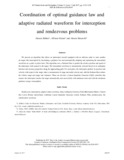- CERES Home
- →
- Cranfield Defence and Security
- →
- Staff publications (CDS)
- →
- View Item
JavaScript is disabled for your browser. Some features of this site may not work without it.
| dc.contributor.author | Balleri, Alessio | |
| dc.contributor.author | Farina, Alfonso | |
| dc.contributor.author | Benavoli, Alessio | |
| dc.date.accessioned | 2017-05-15T12:22:00Z | |
| dc.date.available | 2017-05-15T12:22:00Z | |
| dc.date.issued | 2017-02-22 | |
| dc.identifier.citation | Balleri A, Farina A, Benavoli A. (2017) Coordination of optimal guidance law and adaptive radiated waveform for interception and rendezvous problems. IET Radar Sonar and Navigation, Volume 11, Issue 7, July 2017, pp. 1132-1139 | en_UK |
| dc.identifier.issn | 1751-8784 | |
| dc.identifier.uri | http://dx.doi.org/10.1049/iet-rsn.2016.0547 | |
| dc.identifier.uri | http://dspace.lib.cranfield.ac.uk/handle/1826/11893 | |
| dc.description.abstract | The authors present an algorithm that allows an interceptor aircraft equipped with an airborne radar to meet another air target (the intercepted) by developing a guidance law and automatically adapting and optimising the transmitted waveform on a pulse-to-pulse basis. The algorithm uses a Kalman filter to predict the relative position and speed of the interceptor with respect to the target. The transmitted waveform is automatically selected based on its ambiguity function and accuracy properties along the approaching path. For each pulse, the interceptor predicts its position and velocity with respect to the target, takes a measurement of range and radial velocity and, with the Kalman filter, refines the relative range and range rate estimates. These are fed into a linear quadratic Gaussian controller that ensures the interceptor reaches the target automatically and successfully with minimum error and with the minimum guidance energy consumption. | en_UK |
| dc.language.iso | en | en_UK |
| dc.publisher | Institution of Engineering and Technology | en_UK |
| dc.rights | Attribution-Non-Commercial 3.0 Unported (CC BY-NC 3.0) You are free to: Share — copy and redistribute the material in any medium or format, Adapt — remix, transform, and build upon the material. The licensor cannot revoke these freedoms as long as you follow the license terms. Under the following terms: Attribution — You must give appropriate credit, provide a link to the license, and indicate if changes were made. You may do so in any reasonable manner, but not in any way that suggests the licensor endorses you or your use. Information: Non-Commercial — You may not use the material for commercial purposes. No additional restrictions — You may not apply legal terms or technological measures that legally restrict others from doing anything the license permits. | |
| dc.subject | linear quadratic Gaussian control | en_UK |
| dc.subject | velocity measurement | en_UK |
| dc.subject | airborne radar | en_UK |
| dc.subject | Kalman filters | en_UK |
| dc.subject | aircraft communication | en_UK |
| dc.title | Coordination of optimal guidance law and adaptive radiated waveform for interception and rendezvous problems | en_UK |
| dc.type | Article | en_UK |
Files in this item
This item appears in the following Collection(s)
-
Staff publications (CDS) [1209]
